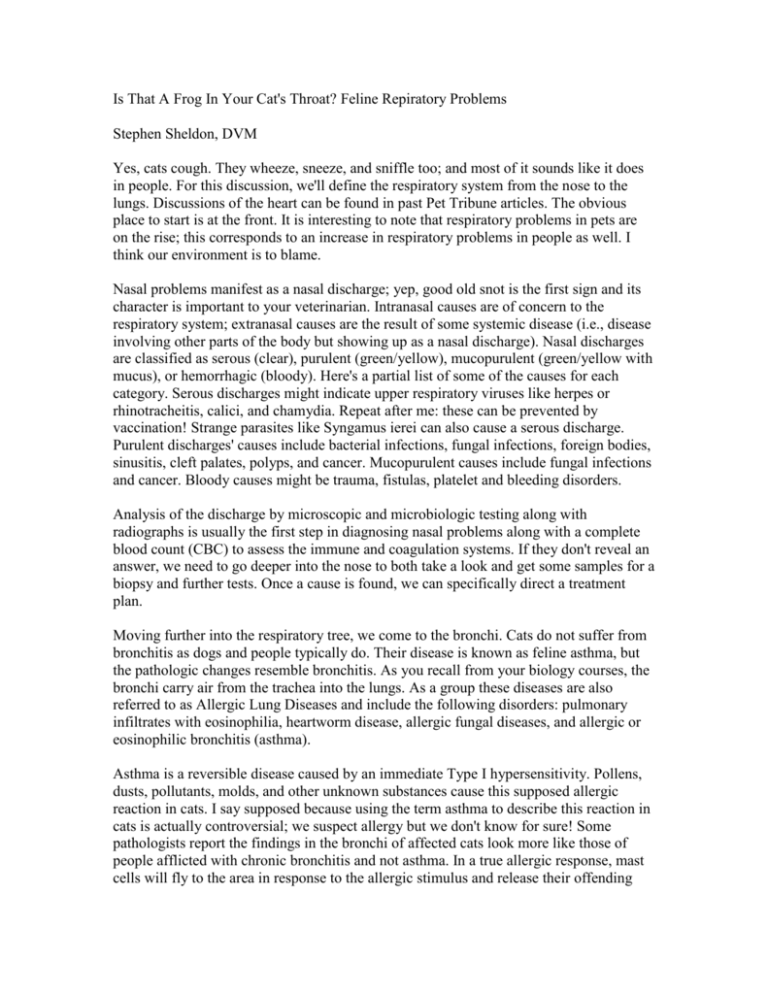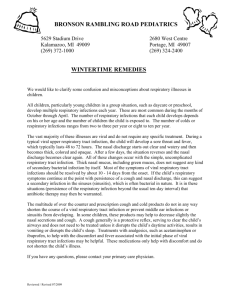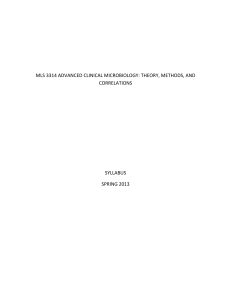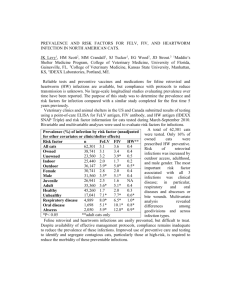Is That A Frog In Your Cat`s Throat? Feline Respiratory Problems
advertisement

Is That A Frog In Your Cat's Throat? Feline Repiratory Problems Stephen Sheldon, DVM Yes, cats cough. They wheeze, sneeze, and sniffle too; and most of it sounds like it does in people. For this discussion, we'll define the respiratory system from the nose to the lungs. Discussions of the heart can be found in past Pet Tribune articles. The obvious place to start is at the front. It is interesting to note that respiratory problems in pets are on the rise; this corresponds to an increase in respiratory problems in people as well. I think our environment is to blame. Nasal problems manifest as a nasal discharge; yep, good old snot is the first sign and its character is important to your veterinarian. Intranasal causes are of concern to the respiratory system; extranasal causes are the result of some systemic disease (i.e., disease involving other parts of the body but showing up as a nasal discharge). Nasal discharges are classified as serous (clear), purulent (green/yellow), mucopurulent (green/yellow with mucus), or hemorrhagic (bloody). Here's a partial list of some of the causes for each category. Serous discharges might indicate upper respiratory viruses like herpes or rhinotracheitis, calici, and chamydia. Repeat after me: these can be prevented by vaccination! Strange parasites like Syngamus ierei can also cause a serous discharge. Purulent discharges' causes include bacterial infections, fungal infections, foreign bodies, sinusitis, cleft palates, polyps, and cancer. Mucopurulent causes include fungal infections and cancer. Bloody causes might be trauma, fistulas, platelet and bleeding disorders. Analysis of the discharge by microscopic and microbiologic testing along with radiographs is usually the first step in diagnosing nasal problems along with a complete blood count (CBC) to assess the immune and coagulation systems. If they don't reveal an answer, we need to go deeper into the nose to both take a look and get some samples for a biopsy and further tests. Once a cause is found, we can specifically direct a treatment plan. Moving further into the respiratory tree, we come to the bronchi. Cats do not suffer from bronchitis as dogs and people typically do. Their disease is known as feline asthma, but the pathologic changes resemble bronchitis. As you recall from your biology courses, the bronchi carry air from the trachea into the lungs. As a group these diseases are also referred to as Allergic Lung Diseases and include the following disorders: pulmonary infiltrates with eosinophilia, heartworm disease, allergic fungal diseases, and allergic or eosinophilic bronchitis (asthma). Asthma is a reversible disease caused by an immediate Type I hypersensitivity. Pollens, dusts, pollutants, molds, and other unknown substances cause this supposed allergic reaction in cats. I say supposed because using the term asthma to describe this reaction in cats is actually controversial; we suspect allergy but we don't know for sure! Some pathologists report the findings in the bronchi of affected cats look more like those of people afflicted with chronic bronchitis and not asthma. In a true allergic response, mast cells will fly to the area in response to the allergic stimulus and release their offending substance (i.e., Histamine). These cause bronchoconstriction, mucus formation, swelling, and inflammation. The diagnosis of feline asthma can usually be accomplished with a CBC and a chest radiograph. Radiographs produce a distinct pattern in the chest; your doctor may be looking for donut holes! Often films may need to be repeated in 2-3 weeks as changes in radiographs can lag behind clinical signs by a few weeks. Sometimes a transtracheal wash is needed to collect fluids for analysis just like in nasal problems. Steroids are the mainstay of treatment for feline asthma and can be given as pills or periodic injections. I have had equal success using both but I prefer oral medications, as they are a little easier to control. For those afraid of steroids we can try antihistamines first and/or bronchodilators but they are not as effective. The lungs are the next stop and you know what this means: pneumonia, folks. Viruses, bacteria, and fungi all cause pneumonia. Use of newer improved vaccines in the last decade has significantly decreased the incidence of viral respiratory infections. However, bacterial and fungal infections are still commonplace and serious. Clinical signs of pneumonia include cough, fever, dyspnia (difficult breathing), nasal discharge, anorexia, depression, dehydration, and weight loss. Dyspnea in cats can be subtle; often the only noticeable change is an extension of the neck and a cowering posture in which the elbows become greatly flexed. It looks like your cat is prowling and getting ready to pounce on a prey. The diagnostic approach is similar to that for bronchial diseases: a CBC, chest radiographs, and a transtracheal wash are indicated. This wash may be the only way your veterinarian will be able to diagnose a fungal infection. Radiographs in fungal infections may show a different pattern than they would in a bacterial or viral infection as the fungi often cause granuloma formation. Once a cause has been found, the proper antimicrobial drugs can be started. These drugs are used for longer times and at higher doses than for other infections; this is because levels of antimicrobials are lower in respiratory secretions than in other tissues. Maintaining good hydration is also important in getting good concentrations of drugs into the lungs so fluid intravenous fluid therapy is often required. Nebulization (aerosol therapy) will help also and should be done 3-4 times daily for about half an hour. Using bronchodilators helps when nebulizing. Immediately after aerosol therapy, physical therapy should be performed. This includes a little exercise, chest wall coupage/massage, and postural drainage (meaning hold their heads down and let the crud drain!). Seriously dyspnic patients may require oxygen therapy. You need to be careful in using cough medications at this point as they interfere with normal movement of mucus and removal of crud. Managing respiratory diseases is a little more difficult in cats compared to dogs. This is because it is a little harder to assess responses to treatment in cats as they are by nature more reclusive than dogs. Nonetheless, it is a skill well learned by your veterinarian so pay attention to their advice!







